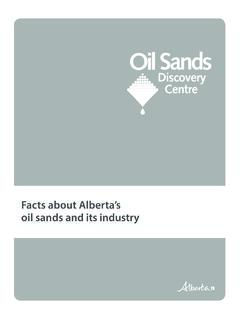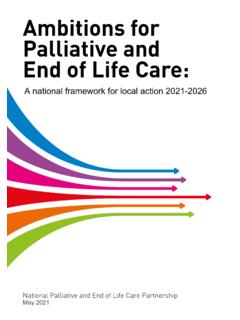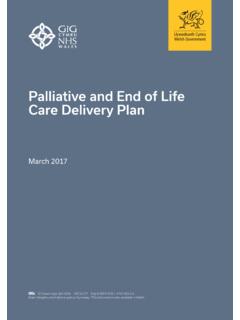Transcription of Palliative and End-of-Life Care Grant Fund Guidelines
1 Classification: Public PEOLC Grant Fund | Guidelines on eligibility and applying for funding | November 2021 2 Classification: Public Palliative and End-of-Life Care Grant Fund: Guidelines on eligibility and applying for funding Published by Alberta Health November 2021 2021 Government of Alberta. This publication is issued under the Open Government License Alberta ( ). This publication is available online at PEOLC Grant Fund | Guidelines on eligibility and applying for funding | November 2021 3 Classification: Public Table of Contents 1. Purpose and Objectives .. 4 2. Program Overview .. 5 3. Funding .. 6 4. Eligibility Requirements .. 6 Eligible projects .. 6 Ineligible projects.
2 7 Eligible organizations and entities .. 8 Ineligible organizations and/or applicants .. 8 Criteria .. 8 Project outcomes .. 9 Eligible and ineligible expenses .. 9 5. Application Process .. 10 6. Application Review .. 11 7. Notification .. 14 8. Reporting 14 9. Funding Conditions .. 14 Project 14 Change of project scope .. 15 10. Acknowledgment of Standards and Requirements .. 15 11. Conflict of Interest .. 15 12. Freedom of Information and Protection of Privacy (FOIP) Act .. 16 13. Contact Information .. 16 PEOLC Grant Fund | Guidelines on eligibility and applying for funding | November 2021 4 Classification: Public 1. Purpose and Objectives Palliative and End-of-Life care (PEOLC) is an approach to care (spanning the continuum of care from the diagnosis of a life-limiting or life-threatening illness to End-of-Life and bereavement) that not only addresses the physical experience of illness and treatment, but also focuses on psychological, spiritual and social domains.
3 As a national leader in the design and implementation of integrated PEOLC, Alberta has implemented a number of initiatives providing those with a life-limiting illness quality of life and support for their families and caregivers. However, despite this integrated system, a number of gaps remain. The Government of Alberta has prioritized PEOLC, recognizing that there is still progress to be made to ensure quality PEOLC for all Albertans. As such, $20M was committed to address the following four priorities: Raise public awareness of Palliative care and how and when to access it; Develop effective caregiver supports to support Albertans in their home and community; Establish and implement Palliative care education, training, and standards for health professionals; and Continue to shift from hospital to community-based home and hospice care To date, approximately $9M has been committed to fund Grant projects and health initiatives that address a number of these priority areas.
4 In September 2020, MLA Dan Williams (Peace River) began targeted engagement to understand what is working in relation to PEOLC, where gaps and barriers remain and where additional investments should be targeted. In November 2021, the Advancing Palliative and End-of-Life Care in Alberta report was released. This report summarizes the consultation and identifies four recommendations to the Government of Alberta for focused investment related to PEOLC. These recommendations are: RECOMMENDATION 1: Earlier Access Primary care (Primary Care Networks, physician offices, and community health centres) and continuing care (home care and facility-based continuing care) providers should adopt the Palliative approach to care once an individual is diagnosed with a life-threatening or life-limiting condition, including age-related chronic conditions such as dementia.
5 This includes establishing quality standards and standards of practice for these care settings. RECOMMENDATION 2: Education and Training PEOLC competencies, the Palliative approach to care, its benefits and serious illness conversations should be incorporated into health care and allied service provider entry-to-practice curricula and continuing professional development. Health service providers and/or community organizations should develop standardized training for families, caregivers and volunteers to increase their capacity to care for their loved ones at home and in their communities. PEOLC Grant Fund | Guidelines on eligibility and applying for funding | November 2021 5 Classification: Public RECOMMENDATION 3: Community Supports and Services Government, AHS, and their partners, should grow and expand community-based PEOLC services via home and community care programs and facility-based continuing care.
6 This includes establishing effective caregiver supports, such as respite, and offering high-quality grief and bereavement services. RECOMMENDATION 4: Research and Innovation Government should invest in establishing additional navigation and care pathways for the transition of chronic disease management to PEOLC while considering access, barriers to services and addressing social determinants of health PEOLC funding will be provided to successful recipients whose projects address these priority areas, and in turn, support the overall provision of quality PEOLC for all Albertans. 2. Program Overview Fund Overview Funding Categories and Funding Allocations Earlier Access: $1M to $2M Education and Training and/or Community Supports and Services: $7M to $8M Research and Innovation: $1M to $2M Project Length Projects start dates are anticipated to be March/April 2022 with project completion by March 31, 2024.
7 Application Deadline January 7, 2022 Application Process 1. Read the PEOLC Grant Fund Guidelines and complete the Palliative and End-of-Life Care Grant Fund Application 2. Submit applications to by January 7, 2022. Applicants may be asked to submit or present supplementary information. Grant Agreement Grant agreement upon funding approval Reporting Requirements (as specified in the Grant agreement) Interim Reporting Completed approximately every 6 months. Includes progress update and interim financial reporting Final Report Includes outcomes reporting, final evaluation and financial reporting PEOLC Grant Fund | Guidelines on eligibility and applying for funding | November 2021 6 Classification: Public 3.
8 Funding The PEOLC Grant funding is one-time only. Funding will not be provided for ongoing operational costs associated with community PEOLC spaces, such as health and/or accommodation costs. Additionally, funding will not cover capital costs associated with building or renovating community PEOLC spaces or operational and administrative costs beyond those related directly to the project. The PEOLC Grant funding is also time-limited. Successful applicants will have until March 31, 2024 to complete their Grant activities (anticipated project start date is March/April 2022). The funding may be provided to successful applicants in installments. The funding schedule will be set out in the Grant agreement.
9 Funding will be allocated accordingly: Earlier access: $1M to $2M Education and training and/or Community supports and services: $7M to $8M Research and innovation: $1M to $2M Funding applications can be project based ( development or expansion of programs, services, training, education, etc.) or research based ( focused on answering a research question, etc.). Research based applications will be limited to applying for funding in the Research and Innovation category. In addition, applicants are to indicate what total amount of funding they are requesting. Funding requests should not exceed the maximums indicated for each priority area above. Proposals may be approved at a lesser amount than what was requested.
10 4. Eligibility Requirements Eligible projects Organizations applying for funding must demonstrate that their proposed project aligns with at least one of the following priority areas. For more information about these priority areas, refer to the Advancing Palliative and End-of-Life Care in Alberta Report. 1. Earlier Access: Eligible projects may include but are not limited to: o Developing innovative approaches to PEOLC system and resource navigation for health care and allied service providers, families, caregivers and patients; o Improving integration of Palliative and End-of-Life care awareness and support ( development and adoption of technologies and platforms to link community-based providers with Palliative care specialists) to improve access to essential PEOLC services.














